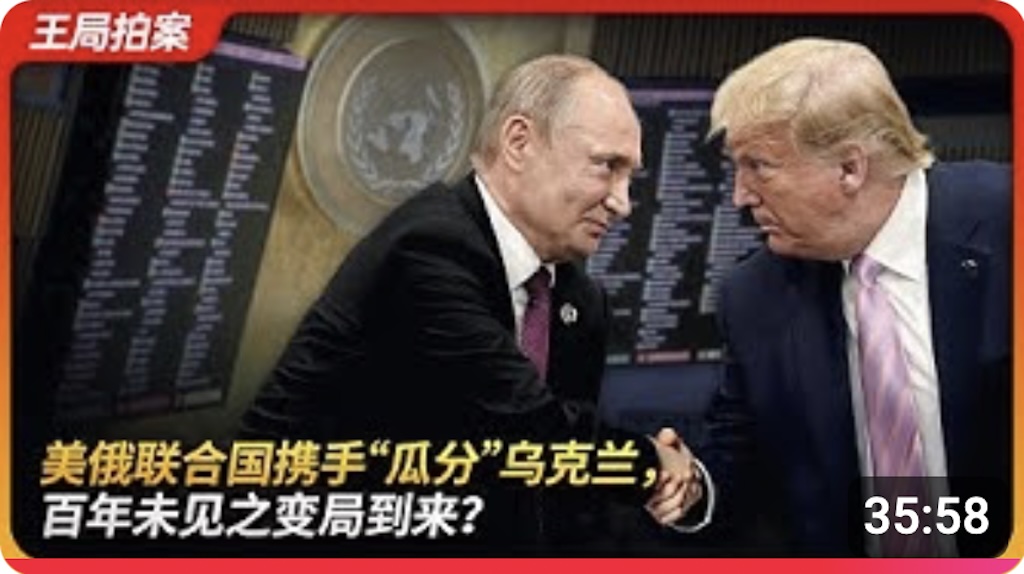#ChatGPT gives a summary, based on the above YouTube video transcripts.
這段影片主要討論了2024年2月24日於聯合國召開的關於烏克蘭局勢的緊急會議,並重點分析了美國與俄羅斯罕見地在該議題上聯手投下反對票,這一結果震驚了國際社會。評論指出,這或許標誌著「百年未有之大變局」。
背景與決議內容
2月24日是俄烏戰爭爆發三周年。烏克蘭在會議上提出了一項決議,重申俄羅斯對烏克蘭的行為屬於武裝入侵,要求尊重各國領土完整並促使俄羅斯無條件撤軍。相比兩年前的一周年決議,這次的決議更加溫和,刪除了要求調查俄羅斯戰爭罪行的內容,並加入了對朝鮮捲入戰爭的批評。
美俄立場與表決結果
此次表決的結果為:
- 93票贊成(主要為歐洲國家及烏克蘭的傳統盟友)
- 18票反對(包括美國、俄羅斯、匈牙利、以色列、朝鮮、伊朗和白俄羅斯等)
- 65票棄權(中國領銜投下棄權票,延續其中立立場)
特別值得注意的是,美國和俄羅斯罕見地在該議題上聯手投下反對票,引發國際媒體廣泛關注。與兩年前相比,支持烏克蘭的國家數量明顯減少,反映出美國立場的變化對國際支持度造成的影響。
美國提出的替代決議
表決結束後,美國提出了一項更為簡化的決議,內容包括:
- 悼念衝突期間的生命損失,並使用了「俄羅斯聯邦與烏克蘭衝突」這一中性表述,未提及「入侵」一詞。
- 重申聯合國維護國際和平與安全的宗旨,但未強調禁止使用武力解決爭端的原則。
- 呼籲迅速結束衝突並促進持久和平,但未提及維護烏克蘭領土完整的問題。
這些變化顯示出美國立場趨於溫和,甚至在用詞上與中國立場趨於一致。
俄羅斯修正案及最終結果
俄羅斯對美國決議提出修正案,要求解決戰爭根源,包括北約不得東擴及烏克蘭保持中立。然而,該修正案最終以31票贊成、71票反對、59票棄權遭到否決。中國與俄羅斯投下贊成票,美國則投下反對票。
總結來看,儘管烏克蘭的決議最終獲得通過,但美國立場的轉變以及國際支持度的減少,對烏克蘭而言是危險且無奈的信號。這次會議反映出國際秩序和大國博弈的微妙變化,美俄在聯合國的意外「合流」或將為未來的地緣政治局勢帶來深遠影響。
The YouTube video discusses a surprising development during a United Nations emergency meeting on February 24, regarding the Ukraine crisis. The key highlight was the unexpected alliance between the United States and Russia, both voting against a Ukraine-backed resolution. This event shocked the international community, given the long-standing rivalry between the two nations.
Key Points:
Background of the Meeting:
- The meeting marked the third anniversary of the Russia-Ukraine war.
- Ukraine had previously introduced similar resolutions, which, though lacking binding force, carried moral authority by demonstrating international support.
Ukraine’s Resolution:
- Reaffirmed Russia’s invasion of Ukraine.
- Emphasized respect for territorial integrity per the UN Charter.
- Called for Russia’s unconditional withdrawal.
- This year’s resolution was more moderate than previous ones, notably omitting calls for war crime investigations but mentioning North Korea’s involvement.
U.S.-Russia Unexpected Alignment:
- The U.S. had warned its European allies against supporting Ukraine’s resolution, signaling a policy shift.
- Ultimately, the resolution passed with 93 votes in favor, 18 against (including the U.S. and Russia), and 65 abstentions—a notable decline in support for Ukraine compared to previous years.
Reactions from Key Nations:
- Ukraine: Stressed Russia’s use of force undermines international order.
- Russia: Urged rational voting, implying its occupation of Ukrainian territories should be recognized.
- United States: Focused on a “forward-looking” approach, emphasizing peace negotiations over condemning past actions.
- China: Maintained a neutral stance, calling for negotiations.
- European Allies: France, the UK, and Canada stressed that peace should not come at the cost of rewarding aggression.
The U.S. Counter-Resolution:
- Contained neutral language, referring to the conflict as “the Russia-Ukraine conflict” instead of “Russian invasion.”
- Omitted references to Ukraine’s territorial integrity, aligning with China’s rhetoric.
- Emphasized general peace without addressing the root causes of the conflict.
Russia’s Amendments and Outcome:
- Russia proposed an amendment linking peace to NATO’s non-expansion and Ukraine’s neutrality, which failed to pass.
- The final vote reflected diminishing international support for Ukraine, signaling a potentially dangerous shift in global diplomacy regarding the conflict.
Conclusion:
The meeting revealed a significant geopolitical shift. The U.S.’s softened stance toward Russia and the reduced global backing for Ukraine suggest a new phase in the conflict, raising questions about future international responses and Ukraine’s strategic position.

